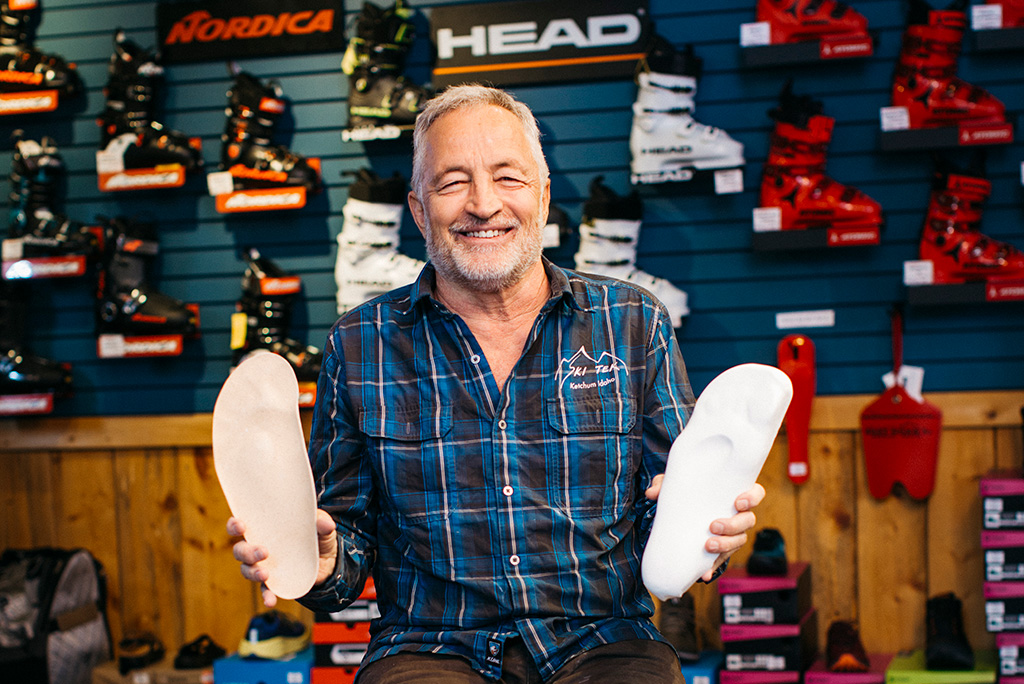“The average human takes 225 million steps in a lifetime; however, due to the activity level of folks in the Wood River Valley, that total would easily be 300 to 400 million steps. Just one trip up to Pioneer Cabin can easily top 25,000 steps.”
That’s Brent Hansen, the chief cook and bottle washer at Ski Tek, a jubilant fellow that has had a lifetime of athletic excellence. Name any sport, and it is likely that Hansen has not only experimented with it but also excelled. Skiing has obviously been his number one sport since his family built the Pomerelle Ski Area decades ago. He has raced downhill nationally and in Europe and even dabbled in speed skiing (with a top speed of 119 miles per hour).
In addition to alpine skiing, Hansen has been a kayaker, climber, paraglider, Nordic skier, and cyclist. And, in each pursuit, his strive towards excellence was the norm. He won the very first Boulder Mountain Tour, spent countless days kayaking the Payette River and paraglided here in the States and in Europe. It was in Greenhorn Gulch where death almost came knocking when his paraglider failed, and he crashed. That injury and his resulting rehab turned his attention to how the body really functions and how to perform at the top of your game. As he describes his life back in the 1970s and ’80s, he calls it a “smorgasbord of sports” that were rugged and raw.
During the early 1970s, Hansen worked part time in the back rooms of the Scott Boot plant. He experimented with the moldable liner foam to mold footbeds with the intention of allowing the foot to feel the ski and the ski’s edge in the most sensitive manner. His goal was to create the connection between the foot and the ski that would resemble the sensitivity similar to a Porsche in a high-speed turn, rather than the squishiness of a 1975 Chevy Suburban. With his experience as a downhill racer, Hansen discovered that the better the connection between foot and ski edge, the faster he went. He likes to describe the action as a “soft touch,” making it possible for the downhill skis to float without any restriction. Too much friction, and everything slows down.
Fast forward to today, and Hansen predicts that World Cup alpine racers will eventually transition to custom boots made using 3D printing, so that their boots will mimic every curve, bone, and muscle in their foot. Currently, skilled boot technicians like those at Hansen’s shop, Ski Tek, sculpt thick-walled plug boots to follow the athlete’s anatomy. This is very time consuming and therefore costly. The price for these custom ski boots for World Cup competitors can easily top $2,000 per pair. This “glove-like” fit not only provides incredible performances on the icy racecourses of the World Cup but also prevents unnecessary pain and injury. Who among longtime alpine skiers doesn’t remember cranking down the two-sizes-too-small Lange boots just to get a better feel of the skis on the snow? No wonder Hansen counts skiers’ feet as the most damaged he’s seen in his nearly 50 years of his foot fetishes.
What is Hansen’s secret? How has he become the Foot Guru for athletes throughout the Wood River Valley and beyond? Why do top athletes such as cross-country skier Katie Feldman sing Hansen’s praises? “He really cares, not only about our performance on the circuit all season long, but in the off season, as we are running mountain trails and road courses, his focus is on prevention of injury,” says Feldman.
The easy answer is the passion that Brent has for feet and combining that passion with 50 years of activity. He literally has seen every possible foot problem and injury. And in collaboration with Professor of Orthopedics Michael Coughlin of Boise, Hansen has been able to learn from the very best in the field of foot and ankle care. Professor Coughlin has co-written Surgery of the Foot and Ankle, considered the “bible” of the craft.
When visiting for the first time at his shop on Sun Valley Road, Hansen and his expert team will dive into a ton of questions such as what sports, activities, and recreational pursuits you like, what pain you have in your feet and, most importantly, what shoes you wear. He will carefully examine your feet and look especially for any callouses and loss of the under-foot padding. Then, he will tell you about his cousins living in Hawaii, cousins with the healthiest feet he has ever seen because they spend their life shoeless walking in the sand on the beaches. The sand, Hansen explains, forms the perfect support for the arch under foot and is soft enough to not pound the natural padding we all have under our feet. Years of time spent walking on cement gradually eliminates that natural padding, and we end up with bone contacting the ground.
Next, Hansen will have you step into his sand-and-beeswax box, and a cast is made of your feet. The soft sand could fill the metatarsal pad under the foot. With that cast, Hansen starts to work making the ultimate SOFT orthotics. Soft is capitalized because one of Brent’s most strident opinions is that hard orthotics make no sense when the bottom of the foot has greatly reduced
natural “fatty pad.”
Once your cast is complete, then all your shoes can be outfitted with an insert that fits your foot and all its imperfections like a glove. Pain gets vastly reduced or eliminated, and performance excels. Good enough for another hundred million steps perhaps.


